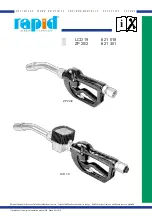
8
• To fire the next nail, repeat the steps above.
• Tools shall be operated at the lowest pressure needed for the application. This will
reduce noise levels, part wear and energy use.
• Adjust the mini pressure which is necessary for the penetration of the nails.
• Then test, starting with the lowest pressure.
4.3 Adjusting depth penetration
A
• The depth that the nail is driven can be adjusted using the depth adjustment next to
the nose of the tool.
1. To drive a nail shallow, turn the wheel (A) to right to the extent desired.
2. To drive a nail deep, turn the wheel to left to the extent desired.
3. Make sure that the trigger and safety yoke move freely up and down without binding
or sticking after each adjustment.
4.4 Jam Clearance
Clearing a Jammed Nail
• Should a nail jam occur, disconnect air supply from tool, keep the tool pointed away
from you and follow these instructions to clear.
1. Press down the door latch and swing the door.
2. Insert the rod into the nose to push the nail back up and into the guide body bore.
3. Remove the jammed nail from driver channel.
4. Extract the nail with pliers or, if the nail is loose, turn the tool upside-down and shake
it out.
Operation in cold weather:
• Do not store the tool in a cold weather environment in order to prevent frost or ice
from forming on the tool’s operating valves and mechanisms. This could cause tool
failure.
• When operation tools at temperatures near and below freezing, the moisture in the air
line may freeze and prevent tool operation.
1. Reduce the air pressure to 5.5 bar or less.
2. Remove all nails from magazine.
3. Connect air and free-fire (blank-fire) the tool. Slow speed operation tends to warm
up the moving part.
Operation in hot weather:
• Keep tool out of direct sunlight as excessive heat can deteriorate bumpers, o-rings
and other rubber parts resulting in increased maintenance.
5. LUBRICATION AND MAINTENANCE
• The tool should be serviced properly and at regular intervals in accordance with the
manufacturer’s instructions.
• While tool is disconnected from air supply, make daily inspection to ensure free
movement of safety yoke and trigger.
• Only use supplied oil or oil recommended in the technical specifications on the tool.
Squirt oil lightly with 2 or 5 oil drops into air inlet.
• Clean magazine, pusher, and safety yoke periodically.
• Lubricate the sliding parts of the magazine occasionally to prevent wear.
• Keep the tool clean and inspect for wear. Do not use flammable cleaning solutions.
• Do not use detergent oil or additives or solvent as they will damage o-rings and
rubber parts.
• Drain compressor tanks and hoses daily.
• Make sure all screws and caps are securely tightened at all times. Loose screws result
in unsafe operation and parts breakage.
PCN90_Manual_2016_ALL.indd 8
2016-06-08 11:52
Содержание PCN90
Страница 73: ...73 PCN90_Manual_2016_ALL indd 73 2016 06 08 11 52...
Страница 74: ...74 PCN90_Manual_2016_ALL indd 74 2016 06 08 11 52...
Страница 76: ...76 2 3 4 4 2 4 3 A 1 A 2 3 4 4 1 2 3 4 PCN90_Manual_2016_ALL indd 76 2016 06 08 11 52...
Страница 77: ...77 1 5 5 2 3 5 2 5 6 PCN90_Manual_2016_ALL indd 77 2016 06 08 11 52...









































